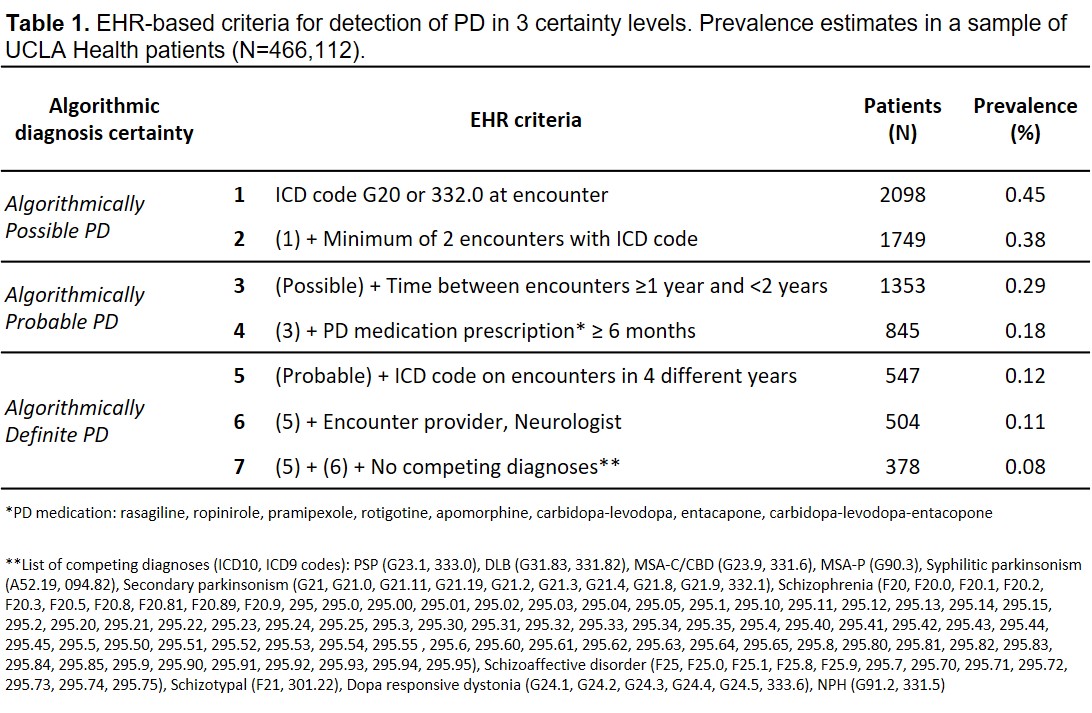Category: Epidemiology
Objective: To develop an EHR-based algorithm to classify patients with PD into three levels of diagnostic certainty.
Background: EHRs can be a rich source of data for cohort identification of patients with PD for population-wide clinical registries, a resource that can improve validity of research studies and quality of health services planning. While traditionally many registries start with ICD codes from clinical encounters for detection of PD patients, algorithms that incorporate more clinical detail from said encounters may increase accuracy of case detection and usefulness of information collected.
Method: We conducted a literature review and consulted neurologist and movement disorder physicians in PD to identify essential components of an automated algorithm to classify PD patients. We reviewed twelve different factors commonly extractable from EHR. Combining encounter and prescription criteria, we developed a three tier system of diagnostic certainty based on progressively more rigorous criteria. The algorithm was then applied to a sample of patients with an UCLA Health encounter between 10/01 and 12/31/2019 using five years of EHR data previous to the encounter date. We estimated prevalence proportions of PD at each level of diagnostic certainty.
Results: Of 466,112 total patients in the EHR system, the algorithm identified 1,768 with possible PD (0.38% prevalence), 853 (0.18%) with probable PD, and 387 (0.08%) with (algorithmically) definite PD. Table 1 presents number and prevalence of PD in the sample when adding each criterion selected. Compared to relying on one ICD code alone, requiring repeated codes, a dopaminergic prescription for at least six months, a clinical encounter with a neurologist, and absence of competing diagnoses reduced prevalence estimates of PD estimated by 82%.
Conclusion: We demonstrate the potential ability of selected EHR-based criteria to titrate certainty in PD case identification when applied to a large clinical sample. Going forward, we will combine this automated EHR classification with a protocol of chart abstraction to determine the recall and precision of our algorithm. Ultimately, this work can become the basis for reliable, accurate, and scalable population-wide PD registries, inclusive of diagnostic certainty categories, such as the California Parkinson’s Disease Registry (CPDR) and the CDC National Neurological Conditions Surveillance System (NNCSS) projects.
To cite this abstract in AMA style:
A. Duarte Folle, L. Uhr, F. Agosta, T. Chang, C. Baddley, B. Ritz, C. Tanner, A. Wu, A. Wilson. Optimizing an Electronic Health Records (EHR)-based Algorithm for Parkinson’s Disease Case Ascertainment [abstract]. Mov Disord. 2021; 36 (suppl 1). https://www.mdsabstracts.org/abstract/optimizing-an-electronic-health-records-ehr-based-algorithm-for-parkinsons-disease-case-ascertainment/. Accessed November 8, 2025.« Back to MDS Virtual Congress 2021
MDS Abstracts - https://www.mdsabstracts.org/abstract/optimizing-an-electronic-health-records-ehr-based-algorithm-for-parkinsons-disease-case-ascertainment/

